Pests Treated – Gold Coast
Cockroaches
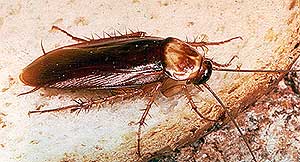 There only 6 families of cockroaches found worldwide, consisting of 4000 species. Australia has representatives of 5 of these families but with only 428 species present. Half of the cockroaches in Australia can be found in the Blattidae family which includes both the native and introduced species. Follow the links below to find out more about the families of cockroaches. Those in bold represent the cockroach families present in Australia.
There only 6 families of cockroaches found worldwide, consisting of 4000 species. Australia has representatives of 5 of these families but with only 428 species present. Half of the cockroaches in Australia can be found in the Blattidae family which includes both the native and introduced species. Follow the links below to find out more about the families of cockroaches. Those in bold represent the cockroach families present in Australia.
For more information, please click here
Spiders
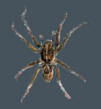 Spiders are invertebrates with a two part body (cephalo thorax and abdomen), biting chelicerae and silk glands that discharge through spinnerets. They have 4 pairs of legs and additional pair of short appendages (pedipalps) beside the chelicerae. Eight is not only the number of legs spiders have. The original spiders and most still have eight eyes and if that is not enough spiders still live today which have the original complement of eight spinnerets.
Spiders are invertebrates with a two part body (cephalo thorax and abdomen), biting chelicerae and silk glands that discharge through spinnerets. They have 4 pairs of legs and additional pair of short appendages (pedipalps) beside the chelicerae. Eight is not only the number of legs spiders have. The original spiders and most still have eight eyes and if that is not enough spiders still live today which have the original complement of eight spinnerets.
For more information, please click here
Redback Spiders
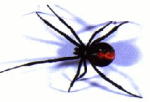 Almost too familiar to need description, mature female redbacks are jet black spiders with a variable red stripe on the back of their spherical abdomen. Their tough, untidy webs are usually near the ground with the spider hiding in a shelter in a corner, often guarding her round woolly egg sacs. Immature females are smaller, usually brown with whitish markings. Males are rarely seen; they are small and brown with red and white markings.
Almost too familiar to need description, mature female redbacks are jet black spiders with a variable red stripe on the back of their spherical abdomen. Their tough, untidy webs are usually near the ground with the spider hiding in a shelter in a corner, often guarding her round woolly egg sacs. Immature females are smaller, usually brown with whitish markings. Males are rarely seen; they are small and brown with red and white markings.
For more information, please click here
Ants
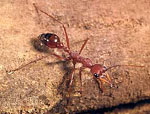 The ant fauna of Australia is especially large and diverse. World-wide, there are 16 subfamilies, about 300 genera and about 15,000 described species and subspecies of ants. Australia is currently known to have representatives of 10 subfamilies, 101 genera and 1275 described species and subspecies.
The ant fauna of Australia is especially large and diverse. World-wide, there are 16 subfamilies, about 300 genera and about 15,000 described species and subspecies of ants. Australia is currently known to have representatives of 10 subfamilies, 101 genera and 1275 described species and subspecies.
For more information, please click here
Fire Ants
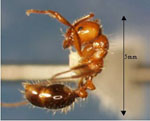 Red Imported Fire Ant, Solenopsis invicta, is a serious new pest which has been detected in Queensland, Australia. They inflict a painful sting and if not eradicated will seriously affect our lifestyle. They are the greatest ecological threat to Australia since the introduction of the rabbit and are potentially worse than the cane toad.
Red Imported Fire Ant, Solenopsis invicta, is a serious new pest which has been detected in Queensland, Australia. They inflict a painful sting and if not eradicated will seriously affect our lifestyle. They are the greatest ecological threat to Australia since the introduction of the rabbit and are potentially worse than the cane toad.
Please click here for more information.
Rodents
 Four species of rodents currently inhabit Sydney Harbour and its environs. One, the Water-rat Hydromys chrysogaster, is a native while the other three, the Black Rat, Rattus rattus, Brown Rat, Rattus norvegicus and House Mouse, Mus domesticus are introduced.
Four species of rodents currently inhabit Sydney Harbour and its environs. One, the Water-rat Hydromys chrysogaster, is a native while the other three, the Black Rat, Rattus rattus, Brown Rat, Rattus norvegicus and House Mouse, Mus domesticus are introduced.
Please click here for more information or CSIRO
Fleas
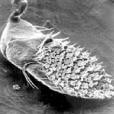 There are 16 different families of fleas worldwide, consisting of about 2380 species. In Australia 9 of these families are represented with just 90 different species. About half of the endemic species that occur in Australia are found in the Pygiopsyllidae family. The Pulicidae family contains many of the introduced fleas such as the cat, dog and human flea, as well as some native species. Follow the links below to find out more about the different families of fleas. Those in bold represent the flea families present in Australia.
There are 16 different families of fleas worldwide, consisting of about 2380 species. In Australia 9 of these families are represented with just 90 different species. About half of the endemic species that occur in Australia are found in the Pygiopsyllidae family. The Pulicidae family contains many of the introduced fleas such as the cat, dog and human flea, as well as some native species. Follow the links below to find out more about the different families of fleas. Those in bold represent the flea families present in Australia.
Please click here or here for more information
Bees
 The insects most beneficial to humans are found in the large insect order Hymenoptera. Not only are the bees and many of their relatives pollinators of flowering plants, including fruits and vegetables, but thousands of species of small wasps are parasites of other arthropods including pest insects. Without these parasites that limit the growth of insect populations, pests would overtake most crops.
The insects most beneficial to humans are found in the large insect order Hymenoptera. Not only are the bees and many of their relatives pollinators of flowering plants, including fruits and vegetables, but thousands of species of small wasps are parasites of other arthropods including pest insects. Without these parasites that limit the growth of insect populations, pests would overtake most crops.
Please click here or here for more information
Wasps
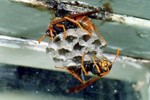 Wasps are a diverse group of insects. In Australia alone there are over 12,000 species, ranging from the tiny diapriid wasps, which are barely visible to the naked eye, to the spider and cicada-killer wasps, capable of taking large prey. Most wasps have carnivorous larvae that feed on other insects and spiders. The adults provide food for them by capturing prey or by laying the egg on or near the food source, which might be an egg, larva or pupa of another insect.
Wasps are a diverse group of insects. In Australia alone there are over 12,000 species, ranging from the tiny diapriid wasps, which are barely visible to the naked eye, to the spider and cicada-killer wasps, capable of taking large prey. Most wasps have carnivorous larvae that feed on other insects and spiders. The adults provide food for them by capturing prey or by laying the egg on or near the food source, which might be an egg, larva or pupa of another insect.
Please click here for more information
Lice
 There are 17 families of lice found worldwide, consisting of about 3000 species. In Australia 14 of these families are represented with 255 species present. This order was previous … divided into just 2 main groups or suborders which separate the bird lice from the mammal lice. It is now divided into 4 suborders. Follow the links below to find out more about the known families of lice.
There are 17 families of lice found worldwide, consisting of about 3000 species. In Australia 14 of these families are represented with 255 species present. This order was previous … divided into just 2 main groups or suborders which separate the bird lice from the mammal lice. It is now divided into 4 suborders. Follow the links below to find out more about the known families of lice.
For more information, Please click here
Silverfish
 There are only 4 families of silverfish found worldwide, consisting of about 370 species. In Australia just 2 of these families are represented with 28 species present. The 2 Australian families are easily separated from others found throughout the world as the Nicoletiidae family are eyeless and the Lepismatidae have only small compound eyes. Follow the links below to find out more about the families of silverfish. Those in bold represent the silverfish families present in Australia.
There are only 4 families of silverfish found worldwide, consisting of about 370 species. In Australia just 2 of these families are represented with 28 species present. The 2 Australian families are easily separated from others found throughout the world as the Nicoletiidae family are eyeless and the Lepismatidae have only small compound eyes. Follow the links below to find out more about the families of silverfish. Those in bold represent the silverfish families present in Australia.
For more information, please click here
Carpet Beetles
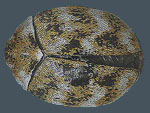 Carpet beetles damage fabrics, furnishings and clothing that contain wool, silk, hair, bristles, fur, or feathers. Synthetic items are resistant to attack, but mixtures of synthetic and natural fibres can be damaged. The natural habitats of carpet beetles are nests of birds, rodents, insects, and spiders. The beetles are pollen feeders and can be found in large numbers in flowers; they can be brought into the house in cut flowers.
Carpet beetles damage fabrics, furnishings and clothing that contain wool, silk, hair, bristles, fur, or feathers. Synthetic items are resistant to attack, but mixtures of synthetic and natural fibres can be damaged. The natural habitats of carpet beetles are nests of birds, rodents, insects, and spiders. The beetles are pollen feeders and can be found in large numbers in flowers; they can be brought into the house in cut flowers.
Please click here for more information
Clothes Moths
 Although less common than carpet beetles, clothes moths are commonly experienced in similar environments to carpet beetles, namely woollen materials, felt, fur and other materials of animal origin.
Although less common than carpet beetles, clothes moths are commonly experienced in similar environments to carpet beetles, namely woollen materials, felt, fur and other materials of animal origin.
The two most common species of clothes moths are the case making clothes moth (Tinea pellionella) and the common clothes moth (Tineola bisselliella).
Please click here for more information
Wood Borers
 Wood borer are insects which damage wood by tunnelling at the larval (grub) stage for food or leaving an emergence hole on the surface of the wood after becoming an adult (beetle). These emergence holes (‘pin holes’) are quite visible and are usually the first signs of an active infestation of wood borer.
Wood borer are insects which damage wood by tunnelling at the larval (grub) stage for food or leaving an emergence hole on the surface of the wood after becoming an adult (beetle). These emergence holes (‘pin holes’) are quite visible and are usually the first signs of an active infestation of wood borer.
For more information, please click here
Timber Decay
The fruiting bodies of wood decay vary in size, shape and colour. The type of fungi encountered by pest inspectors usually reside in poorly ventilated sub floors, below wet areas of the home, exterior timbers and in areas that retain water in the soil. The durability and type of timbers are factors along with the temperature and environment.
Please click here for more information.
Wood Rot
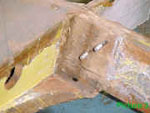 The fruiting bodies of wood decay fungi vary in size, shape and colour. The type of fungi encountered by building inspectors & pest controllers usually reside in poorly ventilated sub-floors, below wet areas of the home, exterior timbers and in areas that retain water in the soil. The durability and type of timbers are factors along with the temperature and environment. Destruction of affected timbers varies with the symptoms involved.
The fruiting bodies of wood decay fungi vary in size, shape and colour. The type of fungi encountered by building inspectors & pest controllers usually reside in poorly ventilated sub-floors, below wet areas of the home, exterior timbers and in areas that retain water in the soil. The durability and type of timbers are factors along with the temperature and environment. Destruction of affected timbers varies with the symptoms involved.
Please click here for more information.
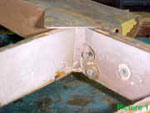

 Integral Pest Management's promise is "service with integrity and honesty", and we uphold that promise every day with our guarantee of a high level of quality pest management service.
We treat every job with the commitment it deserves, we know that your family's health and quality of living can be affected by pest infestation and take every possible step to eradicate the problem for as long as possible and assist with ongoing management.
Integral Pest Management's promise is "service with integrity and honesty", and we uphold that promise every day with our guarantee of a high level of quality pest management service.
We treat every job with the commitment it deserves, we know that your family's health and quality of living can be affected by pest infestation and take every possible step to eradicate the problem for as long as possible and assist with ongoing management.